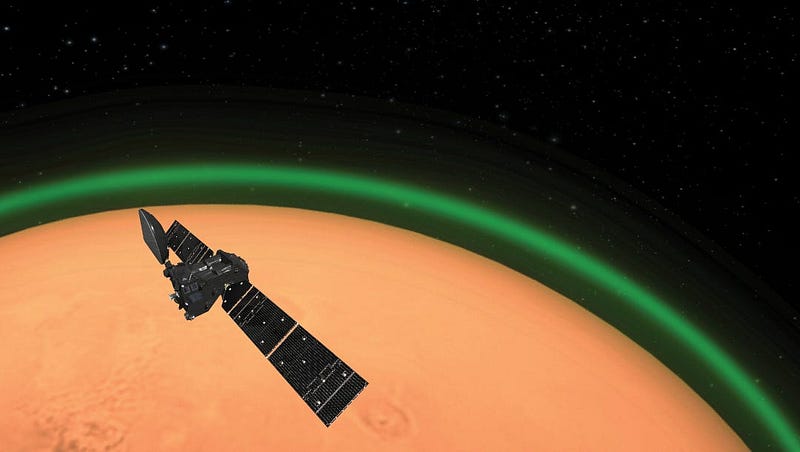A Glimpse of Mars: The Mystique of Its Green Skies
Written on
Chapter 1: The Green Glow of Mars
Recent studies reveal that Mars features a visible dayglow, making it the only other planet, besides Earth, known to possess this phenomenon.

In reflecting on the peculiarities of our world, I often find myself questioning why things are the way they are and imagining alternate realities. Like many children, I was curious about the reasons behind the green grass and blue sky. What if, I wondered, grass were blue and the sky green? While visualizing such a transformation was difficult due to my hazy imagination, recent discoveries allow me to envision a green sky—not on Earth, but on Mars, the rocky red planet.
Previous Research
The European Space Agency's (ESA) Mars Express has been orbiting Mars, examining its atmosphere, climate, geological structure, and mineral composition while searching for water traces.
In 2012, scientists announced that Mars Express had detected infrared nightglow in the Martian atmosphere, published in the Journal of Geophysical Research. Although this finding was captivating, it wasn't groundbreaking, as other planets, including Earth, exhibit similar nightglows. However, since infrared light is invisible to human eyes, we couldn't perceive this glow.
Fast forward to 2020, when the ESA's ExoMars Trace Gas Orbiter (TGO) discovered glowing green oxygen atoms visible during the daytime on Mars. This revelation was more significant since Earth is the only known planet with a visible dayglow.
New Research
Motivated by earlier discoveries, planetary scientist Jean-Claude Gérard from the STAR Institute at the Université de Liège, Belgium, and his team sought to explore further. Equipped with the TGO's NOMAD instruments, which include three spectrometers for measuring light absorption by chemicals, they focused their observations on the edge of Mars' atmosphere.
During the Martian winter at southern polar altitudes of 25 to 37 miles (40 to 60 kilometers), they detected a visible nightglow. Their findings, published in Nature Astronomy, indicated that oxygen atoms formed dioxygen (O2) during the night, generating the captivating green glow, potentially visible from the Martian surface.

Understanding the Glow
The phenomenon mainly revolves around nightglow, but it is scientifically referred to as airglow. The terms "dayglow" and "nightglow" indicate the timing of the glow's occurrence.
Initially, I thought airglow resembled Earth's auroras. However, while they share visual similarities, they are distinct phenomena. NASA describes airglow as the result of atoms and molecules in the upper atmosphere emitting light as they release excess energy, excited by sunlight.
During the day, sunlight causes photodissociation, breaking molecules apart. At night, as the planet turns away from sunlight, these loose atoms recombine into molecules, emitting photons and creating a glow.
While different from the northern lights caused by solar particles interacting with Earth's magnetic field, other planets in our solar system also exhibit airglow. Observing Earth from space reveals layers of golden, green, and hints of red light, while Venus's airglow remains invisible infrared. Jupiter's airglow, initially thought to be ultraviolet, was found to contain less UV light than expected during a 2000s flyby by New Horizons.
The Future of Martian Exploration
Though planetary airglows are not uncommon, Mars' unique glow has significant implications for understanding the red planet. Gérard emphasized that the intensity of the glow in Mars' polar regions could allow for cost-effective instruments in orbit to monitor atmospheric flows. Future ESA missions could incorporate cameras for global imaging, and this glow might even be observable by astronauts from orbit or the Martian surface.
Studying Martian airglows is crucial for deciphering the planet's thin atmosphere and will be essential for future exploration. Insights into the Martian atmosphere could aid in designing spacecraft for travel to Mars and developing satellites capable of stable orbits without succumbing to atmospheric drag.
A Shift in Perspective
Nature is indeed fascinating, revealing wonders even to those unfamiliar with science. Understanding why Earth's sky appears blue while Mars occasionally glows green only enhances the enchantment of the natural world. Despite the thrill of witnessing Mars' green nightglow, I have no desire to travel there. Instead, the images of this unusual sky satisfy my childhood curiosity about alternative colors in our atmosphere.
This article was originally shared in the author's free newsletter, Curious Adventure, and has been edited and republished on Medium with her permission.
Thank you for reading; your support is appreciated.
The first video, "Green for the Red Planet," explores the intriguing discovery of Mars’ green glow, providing insights into the atmospheric phenomena occurring on the planet.
The second video, "The Green Comet and the Red Planet," discusses the relationship between celestial events and Mars' unique atmospheric characteristics, further delving into the science behind these discoveries.